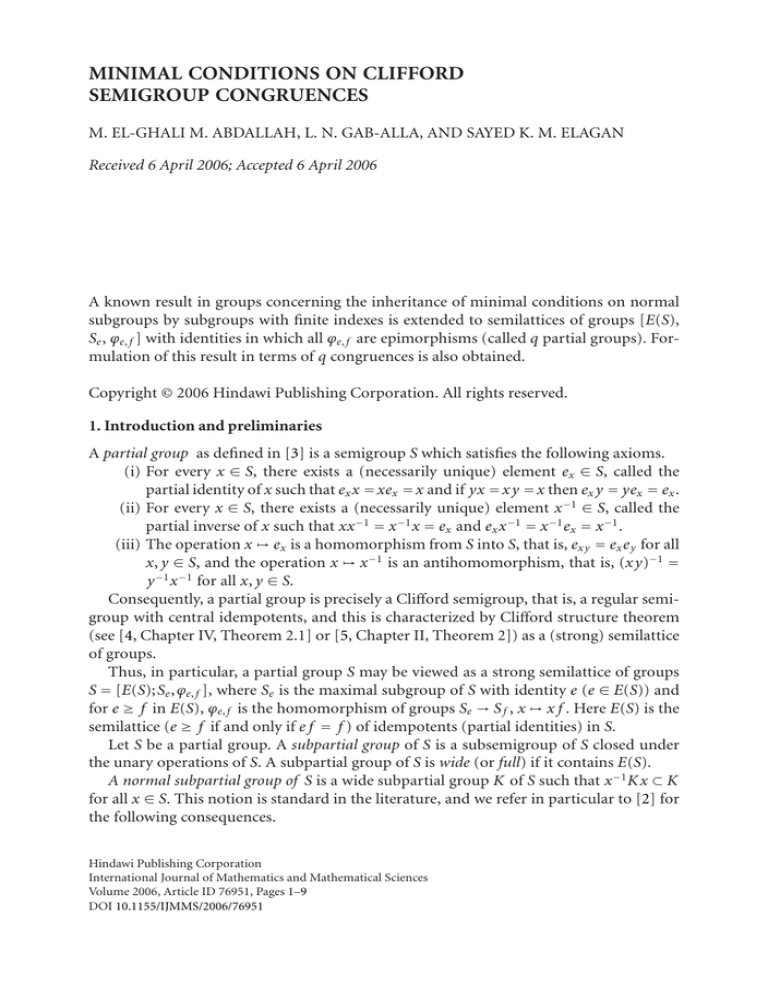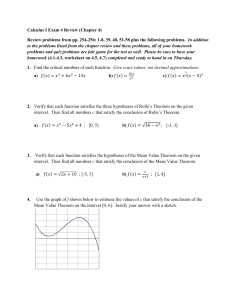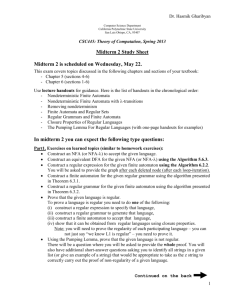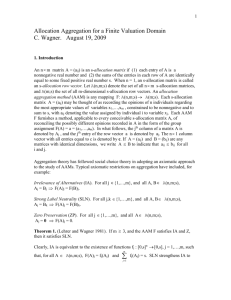
MINIMAL CONDITIONS ON CLIFFORD
SEMIGROUP CONGRUENCES
M. EL-GHALI M. ABDALLAH, L. N. GAB-ALLA, AND SAYED K. M. ELAGAN
Received 6 April 2006; Accepted 6 April 2006
A known result in groups concerning the inheritance of minimal conditions on normal
subgroups by subgroups with finite indexes is extended to semilattices of groups [E(S),
Se , ϕe, f ] with identities in which all ϕe, f are epimorphisms (called q partial groups). Formulation of this result in terms of q congruences is also obtained.
Copyright © 2006 Hindawi Publishing Corporation. All rights reserved.
1. Introduction and preliminaries
A partial group as defined in [3] is a semigroup S which satisfies the following axioms.
(i) For every x ∈ S, there exists a (necessarily unique) element ex ∈ S, called the
partial identity of x such that ex x = xex = x and if yx = xy = x then ex y = yex = ex .
(ii) For every x ∈ S, there exists a (necessarily unique) element x−1 ∈ S, called the
partial inverse of x such that xx−1 = x−1 x = ex and ex x−1 = x−1 ex = x−1 .
(iii) The operation x → ex is a homomorphism from S into S, that is, exy = ex e y for all
x, y ∈ S, and the operation x → x−1 is an antihomomorphism, that is, (xy)−1 =
y −1 x−1 for all x, y ∈ S.
Consequently, a partial group is precisely a Clifford semigroup, that is, a regular semigroup with central idempotents, and this is characterized by Clifford structure theorem
(see [4, Chapter IV, Theorem 2.1] or [5, Chapter II, Theorem 2]) as a (strong) semilattice
of groups.
Thus, in particular, a partial group S may be viewed as a strong semilattice of groups
S = [E(S);Se ,ϕe, f ], where Se is the maximal subgroup of S with identity e (e ∈ E(S)) and
for e ≥ f in E(S), ϕe, f is the homomorphism of groups Se → S f , x → x f . Here E(S) is the
semilattice (e ≥ f if and only if e f = f ) of idempotents (partial identities) in S.
Let S be a partial group. A subpartial group of S is a subsemigroup of S closed under
the unary operations of S. A subpartial group of S is wide (or full) if it contains E(S).
A normal subpartial group of S is a wide subpartial group K of S such that x−1 Kx ⊂ K
for all x ∈ S. This notion is standard in the literature, and we refer in particular to [2] for
the following consequences.
Hindawi Publishing Corporation
International Journal of Mathematics and Mathematical Sciences
Volume 2006, Article ID 76951, Pages 1–9
DOI 10.1155/IJMMS/2006/76951
2
Minimal conditions on Clifford semigroup congruences
Let K be normal in S, Ke is a normal subgroup of Se for every e ∈ E(S).
ρK = {(x, y) ∈ S × S : ex = e y and xy −1 ∈ K } is an idempotent-separating congruence
on S with kerρK = K.
Conversely, if ρ is an idempotent-separating congruence on S, then K = kerρ is a normal subpartial group of S and ρK = ρ.
Let N(S) be the set of all normal subpartial groups of S, and let Ci (S) be the setof all
M is the join N M ,
idempotent-separating congruences on S. For N,M ∈ N(S), N ∨
that is, the smallest normal subpartial group of S containing N M, and we have N ∨
M = NM = MN. For ρ, σ ∈ Ci (S), ρ ∨ σ is defined similarly, and we have ρ ∨ σ = σ ◦ ρ =
ρ ◦ σ. Also ρNM = ρN ◦ ρM for all N,M ∈ N(S). Moreover, we have the following theorem.
Theorem 1.1 [2]. (N(S), ⊂, , ∨) and (Ci (S), ⊂, , ∨) are complete modular lattices and
N(S) → Ci (S), N → ρN is a lattice isomorphism.
For sake of reference, cite from [1] the material required for the present work.
A q partial group is a partial group S with identity 1 such that ϕ1,e : S1 → Se is an epimorphism (i.e., S1 e = Se ) for every e ∈ E(S). This implies clearly that ϕe, f : Se → S f is an
epimorphism for every e, f ∈ E(S) with e ≥ f .
Theorem 1.2 [1]. Let S be a partial group with identity 1. Every wide subpartial group K of
S contains a unique maximal q subpartial group, denoted by Q(K), of S given by (Q(K))e =
Im, ϕ1,e |K1 = K1 e for all e ∈ E(S). That is, Q(K) is a strong semilattice E(S) of groups K1 e.
Also Q(K) is non trivial (i.e., Q(K) = E(S)) if and only if K1 is a nontrivial group.
On the class of partial groups with identities, we have idempotent unary operation
S → Q(S), where Q(S), defind as above, is the unique maximal q subpartial group of S.
Lemma 1.3. Let S be a partial
group with identity
and let {Si , i ∈ I } be a family of wide sub
partial groups of S. Then Q( i∈I Si ) = i∈I Q(Si ). In particular, the join of any family
of q subpartial groups of S is a q subpartial group of S.
A normal subpartial group of a partial group S with identity need not be a q subpartial
group, even if S is a q partial group (e.g., [1, Example 4.4 ]). On the other hand, if S is a q
partial group and N is normal in S, then Q(N) is normal in S.
Let S be a q partial group and let QN(S) be the set of all q normal subpartial groups of S.
Lemma 1.4. QN(S) is a complete modular lattice with meet and join defined by
M ∧ N = Q(M ∩ N),
M ∨ N = MN = M ∪ N .
(1.1)
An idempotent-separating congruence ρ on a partial group S with identity 1 is called
a q congruence if for all x, y ∈ S, xρy implies that x = sy for some s ∈ (kerρ)1 , that is, for
some s ∈ S1 with sρ1.
Lemma 1.5. Let S be a partial group with identity, and let ρ be an idempotent-separating
congruence on S. Then ρ is a q congruence if and only if K = kerρ is a q normal subpartial
group of S. Equivalently for any subpartial group K of S, K is a q normal subpartial group of
S if and only if ρK is a q congruence.
M. El-Ghali M. Abdallah et al. 3
Let S be a partial group with identity 1. The Q operation is defined on idempotentseparating congruences as follows:
Q(ρ) = (x, y) : xρy, x = sy(or x = ys) for some s ∈ S with sρ1 .
(1.2)
Precisely, Q(ρ) is the unique maximal q congruence on S contained in ρ.
Lemma 1.6. Let S be a q partial group and let ρ ∈ Ci (S). Then
Q(ρ) = ρQ(N) ,
where N = kerρ.
Let S be a q partial group and let QCi (S) be the set of all q congruences on S.
(1.3)
Theorem 1.7. With join and meet given by ρ ∨ σ = ρ ◦ σ = σ ◦ ρ and ρ ∧ σ = Q(ρ σ),
QCi (S) is a complete modular lattice and the mapping
QN(S) −→ QCi (S),
N −→ ρN ,
(1.4)
is a lattice isomorphism.
As observed in [1, Section 1], q partial groups exist naturally as partial mappings from
sets to groups. In the present paper, we consider minimal conditions on normal subpartial
groups of partial groups with identities and we discuss the situations with which such
conditions could be inherited by subpartial groups with finite indexes. Our principal goal
is to extend the following known result in groups to appropriate classes of partial groups.
Theorem 1.8 [6, Theorem 3.1.8]. If a group G satisfies min −n and H is a subgroup of G
with finite index, then H satisfies min −n.
In this theorem, min −n is the minimal condition on normal subgroups. In other
words a group G is said to satisfy min −n if any nonempty family of normal subgroups
has a minimal member, or equivalently there does not exist a proper descending chain
N1 ⊃ N2 ⊃ · · · of normal subgroups of G. The proof of the above result depends on the
notion of normal closures and cores in groups. Here we give the definitions and some
properties (see [6, Section I.3]).
If X is a nonempty subset of a group G, the normal closure of X in G, denoted by X G ,
is the intersection of all normal subgroups of G which contains X. Dually, the core of X
in G, denoted by XG , is the join of all normal subgroups of G that contains by X. In other
words, X G is the smallest normal subgroup of G containing X, whereas XG is the largest
one contained in X.
Fact 1.9. X G = g −1 Xg : g ∈ G.
Fact 1.10. For any subgroup H of G, HG =
g ∈G g
−1
Hg.
For our work, we introduce in Section 2 normal closures and cores in partial groups,
showing that
if S is a partial group and ∅ = X ⊂ S, then X S is characterized as in Fact 1.9.
If either X Se = ∅ for all e ∈ E(S) or S has an identity 1 and 1 ∈ X, that S is a q partial
group, and K is a normal subgroup of S1 (the maximal subgroup of S with identity 1),
then K S is a q subpartial group of S.
4
Minimal conditions on Clifford semigroup congruences
We also characterize the (normal) core HS of a wide subpartial group H of a q partial
group S in terms of the group-theoretic cores of He in Se (e ∈ E(S)). HS need not be a q
subpartial group of S, whence we introduce the notion of a q (normal) core showing that
the q core of a wide subpartial group H of a q partial group S is precisely Q(HS ).
In Section 3, we show that a q partial group S satisfies min −qn (the minimal condition on q normal subpartial groups) if and only if S1 satisfies min −n. Introducing the
notions of finite index and local finite index in partial groups (with identities), we show
that min −qn in q partial groups is inherited by q subpartial groups with local finite indexes extending Theorem 1.8.
Whereas for partial groups with identities, we show that min −n implies min −qn for
wide subpartial groups with finite indexes.
These two results can be formulated in terms of (q) congruences. In particular, the
former result may have the version.
In q partial groups, the minimal condition on q congruences is inherited by q subpartial groups with local finite indexes.
2. Normal closures and cores
Given a partial group S and a nonempty subset X of S, we define the normal closure of
X, denoted by X S , to be the intersection of all normal subpartial groups of S containing
X. Evidently, X S is the smallest normal subpartial group of S containing X. Analogous
to the known characterization of normal closures in groups (see Section 1), we have the
following lemma.
Lemma 2.1. Let S be a partial group and let ∅ = X ⊂ S.
(i) If X ∩ Se = ∅ for all e ∈ E(S), then
X S = s−1 Xs : s ∈ S .
(2.1)
In particular, if H is a wide subpartial group of S, then
H S = s−1 Hs : s ∈ S .
(2.2)
(ii) If S has an identity 1 and 1 ∈ X, then
X S = s−1 Xs : s ∈ S .
(2.3)
Proof. (i) Clearly, s−1 Xs : s ∈ S is a subpartial group of S containing X, and by the
hypothesis, it is also wide. Let s ∈ S and let y ∈ s−1 Xs : s ∈ S be a generator, say y =
s−1 1 xs1 , for some s1 ∈ S, x ∈ X. Then s−1 ys = s−1 s−1 1 xs1 s = (s1 s)−1 x(s1 s) ∈ s−1 Xs : s ∈ S.
If y1 ,..., yn are generators in s−1 Xs : s ∈ S, then
s−1 y1 y2 · · · yn s = s−1 y1 ss−1 y2 ss−1 · · · ss−1 yn s
= s−1 y1 s s−1 y2 s · · · s−1 yn s ∈ s−1 Xs : s ∈ S .
(2.4)
Hence, s−1 Xs : s ∈ S is a normal subpartial group of S containing X. Suppose that K
is a normal subpartial group of S and that X ⊂ K. Then for any s ∈ S, x ∈ X, s−1 xs ∈ K
M. El-Ghali M. Abdallah et al. 5
(since x ∈ K), and so s−1 Xs : s ∈ S ⊂ K. Therefore, s−1 Xs : s ∈ S is the normal closure
of X and (i) is proved.
(ii) For any e ∈ E(S), e = e−1 1e ∈ s−1 Xs : s ∈ S. Thus s−1 Xs : s ∈ S is a wide sub
partial group of S containing X. The result follows as in (i).
Lemma 2.2. Let S be a q partial group and let K be a normal subgroup of S1 . Then K S is a q
normal subpartial group of S.
Proof. Let H = K S . By Lemma 2.1(ii), H = s−1 Ks : s ∈ S. Thus, it is sufficient to show
that He ⊂ H1 e for all e ∈ E(S) (which implies that ϕ1,e : H1 → He is an epimorphism for
all e ∈ E(S)). Let e ∈ E(S) be fixed but arbitrary, and let x ∈ He . Since K is a subgroup of
S1 , then x may be written as a product of generators x = x1−1 k1 x1 x2−1 k2 x2 · · · xn−1 kn xn for
some xi ∈ S and ki ∈ K, and i = 1,...,n. We have eki = 1 for all i ∈ I, and so
e = ex = ex 1 ex 2 · · · ex n .
(2.5)
Since S is a q partial group, we have
xi = si exi
(2.6)
x = s−1 1 k1 s1 s−2 1 k2 s2 · · · s−n 1 kn sn ex1 ex2 · · · exn .
(2.7)
for some si ∈ S1 , i = 1, 2, ..., n. Thus
Since K is normal in S1 , ki = s−i 1 ki si ∈ K, i = 1,2,...,n, and we have
x = k1 k2 · · · kn e = ke,
where k = k1 k2 · · · kn ∈ K,
(2.8)
and so x ∈ Ke. Clearly, H1 = (K S )1 = s−1 Ks : s ∈ S1 = K. Thus x ∈ H1 e. Therefore He ⊂
H1 e.
The notion of a core (or normal interior) in groups can be also extended to partial
groups. Let S be a partial group and let H be a wide subpartial group of S. The core
(normal interior) of H in S, denoted by HS , is the join of all normal subpartial groups of S
contained in H. In other words, HS is the largest normal subpartial group of S contained
in H. Cores in q partial groups can be characterized in terms of cores in groups. We have
the following theorem.
Theorem 2.3. Let S be a q partial group and let H be a wide subpartial group of S. Then
(HS )e is the group-theoretic core of He in Se for every e ∈ E(S), that is, HS is a semilattice of
groups
HS = E(S),Ke ,ϕe, f ,
(2.9)
where Ke is the core of the subgroup He in Se , e ∈ E(S).
Proof. By hypothesis, K = e∈E(S) Ke is a union ofdisjoint groups indexed by the semilattice E(S). By Fact 1.10, for every e ∈ E(S), Ke = s∈Se s−1 He s. For e ≥ f in E(S), define
ϕe, f : Ke → K f by x → x f (x ∈ Ke ). To show that K is a semilattice of groups, it is sufficient to show that ϕe, f is well defined in the sense that ϕe, f (Ke ) ⊂ K f for all e ≥ f in E(S).
6
Minimal conditions on Clifford semigroup congruences
Thus, let x ∈ Ke = s∈Se s−1 He s. We must show that x f ∈ K f = s∈S f s−1 H f s. For this, let
s be an arbitrary element of S f . Since (by hypothesis) ϕe, f : Se → S f is an epimorphism,
there exists s1 ∈ Se such that s = s1 f . Now, x ∈ s∈Se s−1 He s implies that x = s−1 1 ys1 , for
. Whence, x f = (s1 f )−1 (y f )(s1 f ) ∈ s−1 H f s. Since s is arbitrary in S f , we
some y ∈ He
obtain x f ∈ s∈S f s−1 H f s = K f . Hence K is a (strong) semilattice of groups. It follows
that K is a subpartial group of S which is clearly wide. To complete the proof, we have to
show that HS = K. Thus it is sufficient to show that K is normal in S, that K ⊂ H, and
that K is the largest with respect to this property. That K ⊂ H follows trivially from the
definition of K. To show that K is normal in S, let x ∈ S and let y ∈ K, say x ∈ Se , y ∈ K f ,
for some e, f ∈ E(S). Thus, xy = xye f , and we have x−1 yx = (x f )−1 (ye f )(x f ). Clearly,
x f ∈ Se f and ye f ∈ Ke f . By the construction of K, Ke f is normal in Se f . It follows that
x−1 yx ∈ Ke f ⊂ K. Thus K is a normal subpartial group of S. Finally, let N be a normal
subpartial group of S such that N ⊂ H. We have for every e ∈ E(S), Ne is normal in Se and
Ne ⊂ He . Since Ke is the core of He in Se , we obtain Ne ⊂ Ke . Therefore N ⊂ K.
Let S be a partial group with 1 and let H be a wide subpartial group of S. We define the
q core of H in S to be the join of all q normal subpartial groups of S contained in H.
Theorem 2.4. If S is a q partial group and H is a wide subpartial group of S, then the q core
of H in S is Q(HS ), where HS is the core of H in S.
Proof. We have HS = N : N S,N ⊂ H , let NH be the family of all normal subpartial
groups N of S contained in H. Then HS = N : N ∈ NH . Let qNH be the family of all q
normal subpartial groups of S contained in H, we have K ∈ qNH if and only if K = Q(N),
for some N ∈ NH , that is, qNH ⊂ {Q(N) : N ∈ NH }. On the other hand, if N ∈ NH , then,
since Q(N) is normal in S [1], we have Q(N) ∈ qNH . Thus, {Q(N) : N ∈ NH } ⊂ qNH .
Then, qNH = {Q(N) : N ∈ NH }. By definition and [1, Lemma 4.2], we have the q core of
H in S which is
K : K ∈ qNH = Q(N) : N ∈ NH
= Q N : N ∈ NH = Q HS .
(2.10)
3. Minimal conditions on q congruences
We use the machinary that has been developed so far to extend a result in groups concerning the inheritance of minimal condition on normal subgroups of a given group to
subgroups with finite indexes, and obtain analogous results for partial groups and q partial groups.
Recall that a partially ordered set (P, ≤) is said to satisfy the minimal condition if any
nonempty subset of P contains a minimal element. This is equivalent to saying that P satisfies the descending chain condition: there does not exist an infinite properly descending
chain x1 > x2 > · · · in P.
In particular, a group G satisfies min −n if (N(G), ⊂) satisfies the minimal condition,
where N(G) is the set of all normal subgroups of G. Analogously, we say that a partial
group S satisfies min −n if (N(S), ⊂) satisfies the minimal condition. Let S be a partial
group with identity 1, we say that S satisfies min −qn if (QN(G), ⊂) satisfies the minimal
M. El-Ghali M. Abdallah et al. 7
condition, or equivalently if there does not exist an infinite properly descending chain
K1 ⊃ K2 ⊃ · · · in QN(S). Here N(S) and QN(S) are defined as in Section 1.
Lemma 3.1. Let S be a partial group with identity 1.
(i) If S satisfies min −n, then S1 satisfies min −n.
(ii) If S1 satisfies min −n, then S satisfies min −qn.
Proof. (i) Suppose that S satisfies min −n but S1 does not. There exists an infinite properly
descending chain
N1 ⊃ N2 ⊃ · · ·
in N S1 .
(3.1)
For each i = 1,2, ..., NiS (the normal closure of Ni in S) is a normal subpartial group of S
and we have a descending chain
N1S ⊃ N2S ⊃ · · ·
in N(S).
(3.2)
for some j.
(3.3)
By min −n of S, we obtain
S
N jS = N j+1
/ N j+1 . We have
Since N j ⊃ N j+1 and N j = N j+1 , there exists some element s ∈ N j with s ∈
S
. Thus, s may be written as an expansion,
s ∈ N jS = N j+1
s = y1−1 x1 y1 y2−1 x2 y2 · · · yn−1 xn yn ,
(3.4)
with yi ∈ S, xi ∈ N j+1 , i = 1,2,...,n. Since es = 1, we must have e yi = 1 for all i = 1,2,...,n,
that is, yi ∈ S1 for all i = 1,2,...,n. Now, N j+1 being a normal subgroup of S1 implies that
yi−1 xi yi ∈ N j+1 , for all i = 1,2, ...,n. Therefore, s ∈ N j+1 , a contradiction.
(ii) Suppose that S1 satisfies min −n but S does not satisfy min −qn. There exists an
infinite properly descending chain
K 1 ⊃ K2 ⊃ · · ·
in QN(S).
(3.5)
For each i = 1,2,...,(Ki )1 is a normal subgroup of S1 , where (Ki )1 is the maximal subgroup of Ki with identity 1. Thus, the above chain induces a descending chain
K1
1
⊃ K2 1 ⊃ · · ·
in N S1 .
(3.6)
Since S1 satisfies min −n, we have for some j
Kj
1
= K j+1 1 .
(3.7)
By assumption, K j ⊃ K j+1 and K j = K j+1 . Thus we must have, for some e ∈ E(S),
Kj
e
⊃ K j+1 e ,
Kj
e
= K j+1 e .
(3.8)
/ (K j+1 )e . Since K j is a q partial group, we have x = se
There exists x ∈ (K j )e such that x ∈
for some s ∈ (K j )1 = (K j+1 )1 . Now, s ∈ (K j+1 )1 , which implies that se ∈ (K j+1 )e and so
x ∈ (K j+1 )e , a contradiction.
8
Minimal conditions on Clifford semigroup congruences
Using Lemmas 3.1(ii), 2.2, and proceeding as in the proof of Lemma 3.1(i), we obtain
the following lemma.
Lemma 3.2. A q partial group S satisfies min −qn if and only if S1 satisfies min −n.
Let S be an arbitrary partial group. A wide subpartial group H of S is said to have a finite
index in S if S = HT, for some finite subset T of S.
Lemma 3.3. Let S be a partial group and let H be a wide subpartial group of S. If H has a
finite index in S, then He has a finite index in Se for every e ∈ E(S).
Proof. By assumption, S = HT, for some finite subset T of S. Let e ∈ E(S) be fixed but
arbitrary. For each x ∈ Se , we have x ∈ Se ⊂ S = HT. Thus x = htx , for some h ∈ H and
tx ∈ T. We have, e = ex = eh etx , and so e ≤ eh and e ≤ etx , that is, eeh = e and eetx = e. Now,
x = htx = (he)tx ∈ He tx = He (etx ). Setting x T = {etx : x ∈ Se }, then clearly x T is a finite
subset of Se and Se ⊂ Hex T. Also, Hex T ⊂ Se Se = Se . Therefore, Se = Hex T, which proves
that He has a finite index in Se .
Let S be a partial group with identity 1 and let H be a wide subpartial group of S. We
say that H has a local finite index in S if H1 has a finite index in S1 . Clearly, by Lemma 3.3,
for a wide subpartial group H of a partial group S with identity, we have a finite index in
S which implies a local finite index in S.
For q partial groups, the implication of Lemma 3.3 may be refined as follows.
Lemma 3.4. Let S be a q partial group and let H be a wide subpartial group of S. If H has a
local finite index in S, then He has a finite index in Se for every e ∈ E(S).
Proof. We have S1 = H1 T, for some finite subset T ⊂ S1 . Let e ∈ E(S), since S is a q partial
group, then Se = S1 e. Thus
Se = H1 Te = H1 e (Te) = H1 e e T,
(3.9)
where e T is the finite set Te ⊂ Se . Since H is wide, H1 e ⊂ H, in particular, H1 e ⊂ He .
Therefore,
Se = H1 e e T ⊂ He e T ⊂ Se .
(3.10)
Thus, Se = He e T and the result follows.
Now we give our main result which is an extension of [6, Theorem 3.1.8].
Theorem 3.5. If a q partial group S satisfies min −qn and H is a q subpartial group of S
with local finite index, then H satisfies min −qn.
Proof. By definition (of local finite index), H1 has a finite index in S1 , and by Lemma 3.2,
S1 satisfies min −n. Since H1 is a subgroup of S1 ,Wilson theorem [6, Theorem 3.1.8] im
plies that H1 satisfies min −n. Again by Lemma 3.2, we have H satisfying min −qn.
For partial groups with identities, we have the following version of Theorem 3.5.
Theorem 3.6. If a partial group S with identity satisfying min −n and H is a wide subpartial group of S with finite index, then H satisfies min −qn.
M. El-Ghali M. Abdallah et al. 9
The proof follows similarly by applying Lemmas 3.1(i), 3.3, [6, Theorem 3.1.8], and
Lemma 3.1(ii).
In view of Theorems 1.7 and 1.1, the above two Theorems (3.5 and 3.6) can be formulated in terms of q congruences and idempotent-separating congruences, respectively.
For instance, by Theorems 1.7 and 3.5, we have the following corollary.
Corollary 3.7. If a q partial group S satisfies the minimal condition on q congruences and
H is a q subpartial group of S with local finite index, then H satisfies the minimal condition
on q congruences.
References
[1] M. E.-G. M. Abdallah, L. N. Gab-Alla, and S. K. M. Elagan, On semilattices of groups whose
arrows are epimorphisms, to appear in International Journal of Mathematics and Mathematical
Sciences.
[2] A. M. Abd-Allah and M. E.-G. M. Abdallah, Congruences on Clifford semigroups, Pure Mathematics Manuscript 7 (1988), 19–35.
, On Clifford semigroups, Pure Mathematics Manuscript 7 (1988), 1–17.
[3]
[4] J. M. Howie, An Introduction to Semigroup Theory, Academic Press, London, 1976.
[5] M. Petrich, Inverse Semigroups, Pure and Applied Mathematics (New York), John Wiley & Sons,
New York, 1984.
[6] D. J. S. Robinson, A Course in the Theory of Groups, Graduate Texts in Mathematics, vol. 80,
Springer, New York, 1982.
M. El-Ghali M. Abdallah: Department of Mathematics, Faculty of Science, Menoufiya University,
Shebin El-kom 32511, Egypt
E-mail address: mohamed elghaly@yahoo.com
L. N. Gab-Alla: Department of Mathematics, Faculty of Science, Menoufiya University,
Shebin El-kom 32511, Egypt
E-mail address: layla nashed2006@yahoo.com
Sayed K. M. Elagan: Department of Mathematics, Faculty of Science, Menoufiya University,
Shebin El-kom 32511, Egypt
E-mail address: sayed khalil2000@yahoo.com









